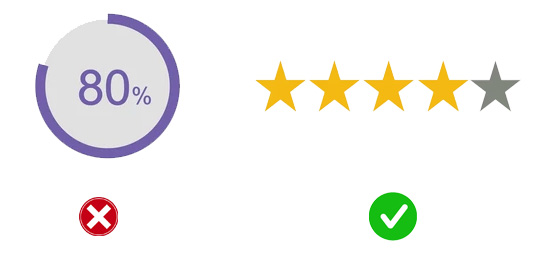How a simple rating can make or break your product
How to use star ratings to influence product perception and boost customer engagement.
Boost engagement with the Persuasive Patterns card deck
Leverage behavioral design techniques to create experiences that users love.
Get your deck!We’ve all instinctively trusted a row of gleaming gold stars as a symbol of quality. But have you ever stopped to consider the psychology behind those little icons?
Research goes beyond the surface appeal of stars. Abell, Morgan, and Romero (2024) examined how the the format of star ratings influence how we perceive a product’s value. It did so significantly. Imagine browsing two products: one boasts a 4-star rating out of 5, while the other displays an 80% positive rating. The researchers found that even though they represent the same level of satisfaction, the product with the 4-star rating is perceived to be more impressive and of higher value. This taps into the anchoring bias, where the 5-star scale creates a mental “anchor” that makes us view the product more favorably. This subtle influence highlights the impact of star ratings on our perception of magnitude.

The power of stars goes beyond mere numbers. Another fascinating study by Hubbard (2005) explores the concept of representational momentum. Picture yourself scrolling through a list of products, each sporting a respectable 4-star rating. Suddenly, a product with 5 stars catches your eye. That single standout visually leaps from the page, appearing “higher” on the screen despite being just one notch above its neighbors. This is an example of salience at play, where visually distinct elements grab attention. The framing effect here further biases our perception, making the 5-star product seem superior simply due to its positioning and standout visual presence.
Pettit et al. (2013) take things a step further. Their research indicates that star ratings can influence a product’s perceived status. Imagine two products with similar ratings: one that has consistently maintained its 4-star rating, and another that recently climbed from 3 stars to 4 stars. The product with the upward trend can be perceived as having more “rising star” status, potentially becoming more desirable in the eyes of consumers. This taps into status bias and our inherent attraction to success stories, playing into optimism bias, where we favor things that appear to be improving or on the rise.
Optimizing your star power
These insights unlock valuable strategies for using star ratings effectively:
- Choose the right format: Consider switching to a 5-star system if you currently use a percentage format. Research suggests that the framing effect of the 5-star system often translates to a stronger perception of value.
- Leverage visual positioning: Feature 5-star reviews prominently. Play with size, color, and placement to ensure these positive ratings grab user attention and trigger the salience effect. Make them stand out from the crowd.
- Highlight positive trends: Showcase products with rising ratings to increase their appeal. Consider using badges or visual cues to highlight products that have recently climbed the star ladder, capitalizing on the “rising star” effect driven by status bias and optimism bias.
By understanding the psychology behind star ratings, you can go beyond a simple indicator of quality and leverage them as a powerful tool to influence user perceptions and, ultimately, drive product success.
Ready to unlock the full potential of product psychology?
The world of product psychology holds a treasure trove of insights beyond the power of stars. My Persuasive Patterns card deck acts as a compass, guiding product teams with insights and practical tips like these. Explore the deck, facilitate workshops, and watch your product innovation soar!
- Abell, A., Morgan, C., & Romero, M. (2024). EXPRESS: The power of a star rating: Differential effects of customer rating formats on magnitude perceptions and consumer reactions. Journal of Marketing Research.
- Hubbard, T. L. (2005). Representational momentum and related displacements in spatial memory: A review of the findings. Psychonomic Bulletin & Review, 12(5), 822-851.
- Pettit, N. C., Sivanathan, N., Gladstone, E., & Marr, J. C. (2013). Rising stars and sinking ships: Consequences of status momentum. Psychological Science, 24(8), 1579-1584.
